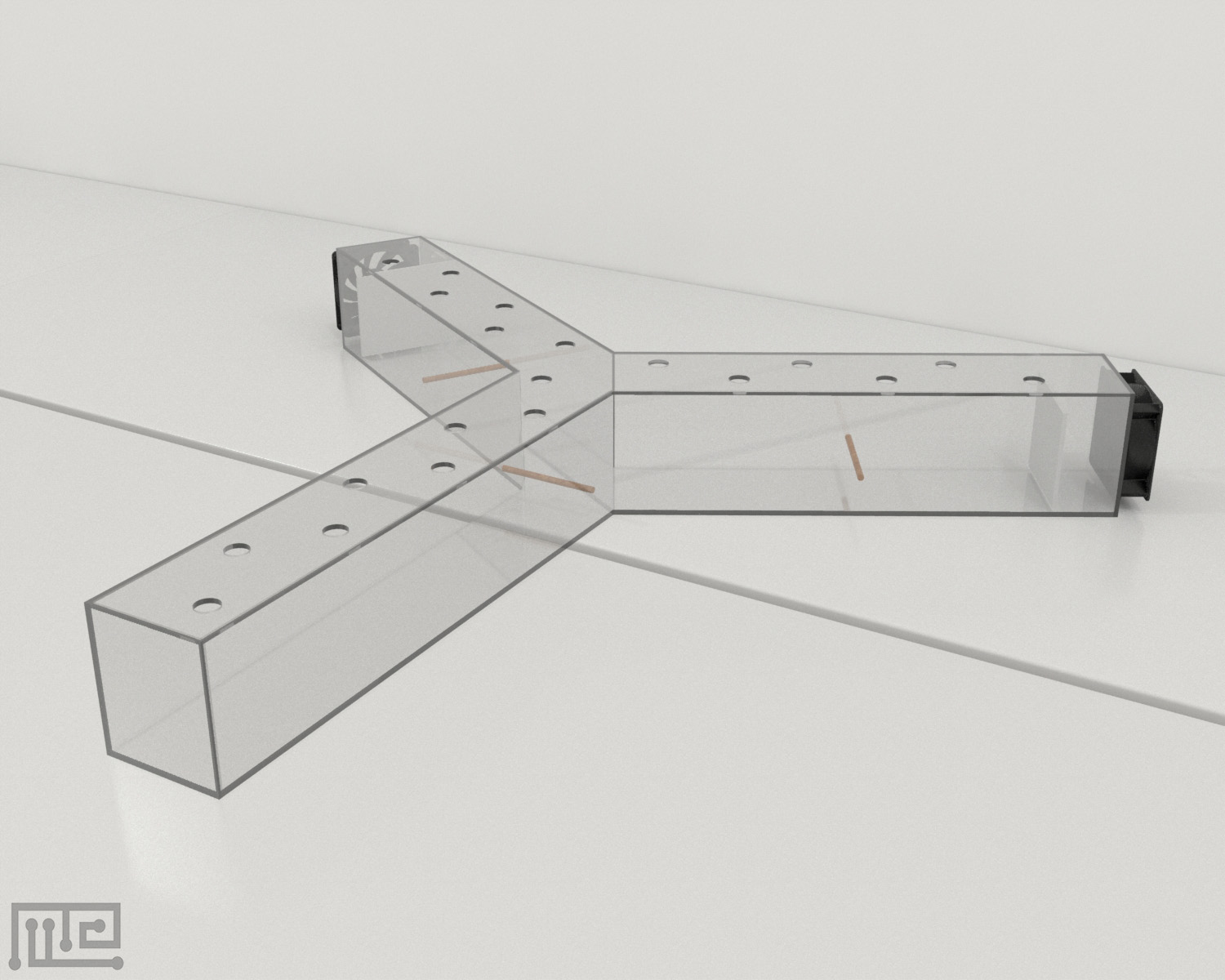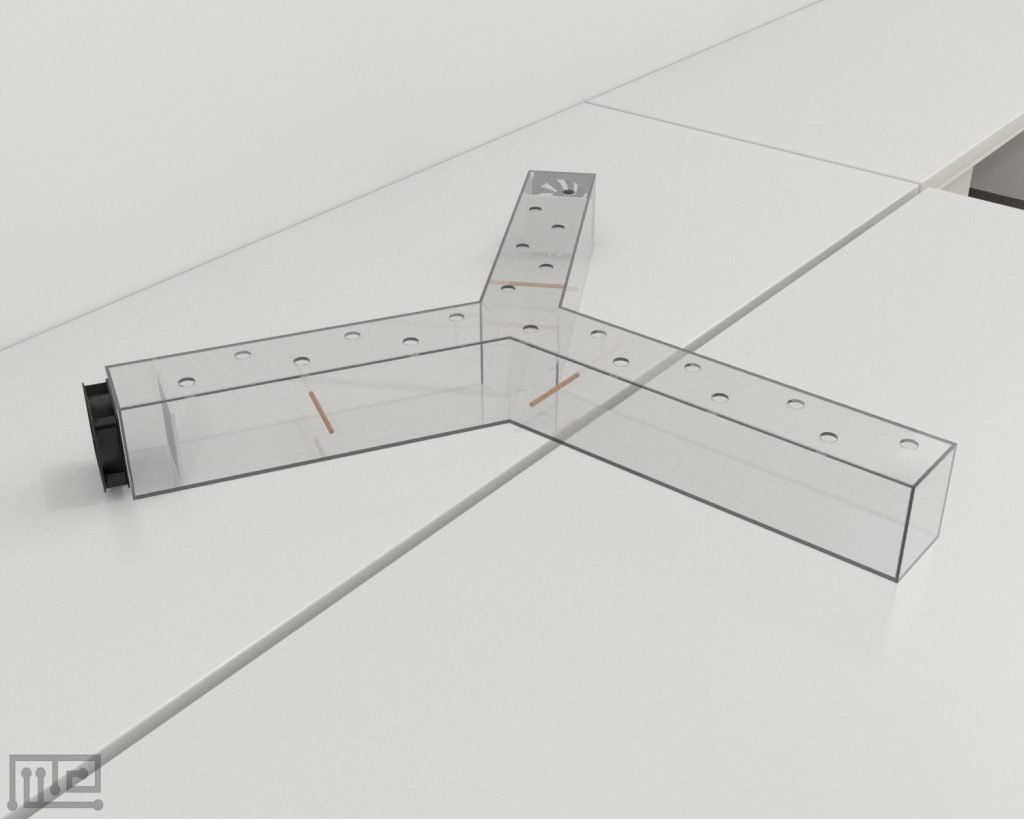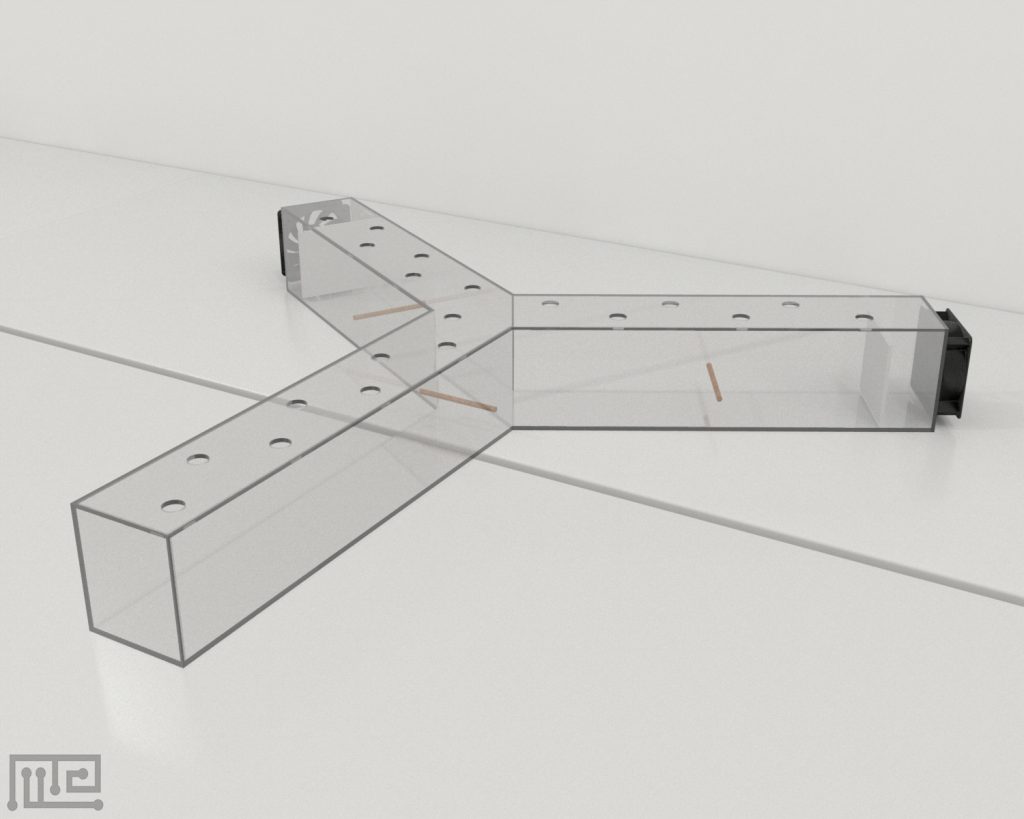The Songbird Y-Maze can be used for different studies and experiment in birds. It was used in a study to investigate the importance of olfactory cues in species recognition in females of two estrildid finch species with different levels of sociality.
It is made of plastic, with a starting arm inside the start box and two identical arms with odor samples located at the end. The entire Y-maze is covered with opaque but light transmissive plexiglass to prevent the birds from escaping.
The entrances to both of the arms of the Y-maze are equipped with light barriers that triggered an optical signal to the observer when a selection is made. The light barriers are placed behind the entrance of the respective arm to ensure that the bird actually entered the arm.
Mazeengineers offers the Songbird Y-Maze.
Price & Dimensions
Songbird Y-Maze
$ 990
+S&H- Length of branching arms: 50cm
- Length of start arm: 50cm
- Length of start box: 14cm
- Width of start box: 12cm
Documentation
Introduction
The Bird Y-Maze is based on the conventional rodent Y-Maze and is used to study choice behaviors in birds based on olfactory cues. The apparatus utilizes a closed design that limits the interferences of external stimuli on the task performances.
A wide number of studies in birds have concentrated their efforts on investigating the use of auditory and visual stimuli in species recognition, foraging, and mating (Matyjasiak, 2005). The primary reason for this fixation was the belief that birds lacked the ability to utilize olfactory cues (Balthazart & Taziaux, 2009). Studies have shown birds to use olfactory cues for kin recognition, self/mate recognition, burrow recognition, and sex recognition (Krause et al., 2014; Bonadonna & Sanz-Aguilar, 2012; Whittaker et al., 2011). The binary choice design of the Bird Y-Maze offers a simple approach to the evaluation of odor discrimination in a wide variety of birds under different investigatory protocols.
The Bird Y-Maze consists of three symmetrical arms that are equally angled from each other. The two choice arms contain compartments at the ends to hold odor stimuli. Stimuli placement and manipulation during trials is made easy by the trap doors that are accessible from the outside. The compartments also prevent the subjects from having direct access to the source. Appropriately placed cooling fans in the maze allow the spreading of the odor cues through the choice arms to the start arm. The start arm is equipped with traps doors to create a temporary isolation chamber, which can be used to reduce stress in the subject. Simple modifications such as visual and auditory stimuli or changing the ceiling transparency allow the use of the Bird Y-Maze for different investigatory purposes.
Other Y-mazes used in the evaluation of choice behaviors in other animals include the Bat Y-Maze, the Snake Y-Maze, the Ant Y-Maze, and the Zebrafish Y-Maze.
Apparatus and Equipment
The Bird Y-Maze is composed of three symmetrical opaque arms (start arm and 2 choice arms) that measure 60 cm in length, 12 cm in width, and 11 cm in height, with a 120° angle between each arm. The starting arm contains two traps doors that are 30 cm apart to provide a temporary holding compartment for the subject. The two choice arms are also equipped with separate compartments at the ends, which are used to hold the odor source and contain trap doors that are accessible from the outside. A second partition is present 20 cm from each choice arm end, which is equipped with cooling fans that provide controlled airflow to carry the odors in the maze.
Training protocol
Thoroughly wash the maze with methanol after each trial to remove odor residues. Appropriately light the apparatus. A tracking and recording system such as the Noldus Ethovision XT can be used to assist with observations.
Bird Y-Maze task
Place the two different odor stimuli in the odor compartments of the choice arms. Turn on the cooling fans for 60 seconds. Place the subject in the holding compartment at the entrance of the Bird Y-Maze for 5 minutes. Lift the trap door and allow the subject to explore the maze. Remove the subject from the maze once it stays in a choice arm for more than 30 seconds or does not make a choice within 15 minutes. Alternate the odor stimuli between arms across trials.
Literature review
Investigation of the assessment of MHC dissimilarity based on odor cues in birds
Leclaire, Strandh, Mardon, Westerdahl, and Bonadonna (2017) investigated whether male and female blue petrels could discriminate against the odor of the opposite sex that varied in major histocompatibility complex (MHC) similarity. Thirty birds (25 females and 10 males) were tested on the Bird Y-Maze and were presented with odors from two individuals of unknown MHC genotype. Odors were collected using cotton swabs and cotton bags. The results indicated that out of the 25 female birds that were tested, 20 made a choice, and out of the 10 males that were tested, 7 made a choice in the Y-maze. When considering amino acid distances between MHC class IIB genotypes, it was observed that half of the females preferred the odor of the more MHC-dissimilar male, whereas 86% of the males oriented towards the odor of the more MHC-dissimilar female. However, when functional distances between MHC class IIB genotypes were considered, 75% of females preferred the odor of the more MHC-similar male, whereas all males that made a choice preferred the odor of the more MHC-dissimilar female. Overall results indicate that birds can detect MHC similarity based on odor cues.
Investigation of the use of olfactory cues for species recognition
Krause et al. (2014) investigated the ability of zebra finches (Taeniopygia guttata) and diamond firetails (Stagonopleura guttata) using olfactory cues to recognize their own species. Twenty females of each species were tested on the Bird Y-Maze using a pairing of conspecific odor and heterospecific odor cues in the choice arms. Odor cues were obtained by placing the donor birds in nylon socks, and the socks were used as odor stimuli. The results indicated that out of the 20 zebra finch females that were used in the experiment, only 9 made a choice towards the conspecific odor cue arm. On the other hand, all 20 diamond firetail females made a choice; however, the preferences were equally divided between the two odors.
Investigation of kin-recognition based on odor cues
Bonadonna and Sanz-Aguilar (2012) investigated whether European storm petrels could identify kin-related birds based on odor cues on the Bird Y-Maze. Odor cues were obtained by rubbing incubating birds with cotton swabs and then placing the swabs in each goal arm. Thirty-eight birds (20 males and 18 females) were used in the experiment and were given a choice between a non-kin odor and a parent or a past-offspring odor. The results indicated that 24 birds made a choice, while 14 birds did not choose a maze arm. It was observed that out of the 24 birds that made a choice, 20 birds approached the non-kin odor. Thus, the results were able to suggest that the birds were capable of distinguishing between kin and non-kin based on olfactory cues.
Investigation of distinction between individual attributes based on preen oil secretion
Whittaker et al. (2011) investigated dark-eyed juncos (Junco hyemalis) for their ability to discriminate species, sexes, and subspecies/populations based on intraspecific preen oil odors. Odor cues were obtained by gently rubbing the preen gland with a capillary tube and then diluting it with acetone. The experiment was conducted on the Bird Y-Maze that included perches placed before the odor stimuli. The birds were first tested for sex preferences using odor pairing of the same-sex and opposite sex. Forty trials were analyzed (22 male subjects, 18 female subjects), and it was observed that the subjects from both sexes preferred the male odor. Tests for population preference were then performed using odors of an opposite-sex individual from their own population and from a different population. Fifty-one trials were analyzed (30 male subjects, 21 female subjects), and it was observed that the males didn’t show any odor preferences. On the other hand, females preferred the odor from the populations that had a smaller body size and a lower amount of tail-white. Tail-white preferences in female subjects were tested using the odor of a male with a high amount of tail white and a low amount of tail white. It was observed that the female subjects didn’t show a preference for either odor.
Investigation of olfactory discrimination by blue petrels
Bonadonna and Mardon (2010) investigated whether blue petrels could discriminate between conspecific and heterospecific odors on the Bird Y-Maze. Thirty-one blue petrels (25 males and 6 females) were used in the experiment. The subjects were presented with a choice between two different odor sources; blue petrels and Antarctic prions. It was observed that 17 birds (12 males and 5 females) selected the choice arm which had their conspecific odor, 7 birds preferred the heterospecific odor (all males), and the remaining 7 birds (6 males and 1 female) did not make a choice and stayed in the entryway. Results indicated that blue petrels could discriminate between the two odors and preferred the conspecific odor over the heterospecific odor.
Data Analysis
The following can be observed using the Bird Y-Maze:
- Number of times subject chose the right maze arm
- Number of times subject chose the left maze arm
- Number of times subject did not make a choice
- Number of correct choices made
- Number of errors
- Time spent in the right maze arm
- Time spent in the left maze arm
- Time taken to complete a trial
Strengths and Limitations
Strengths
The Bird Y-maze offers a simple two-choice design to asses olfactory cue-based choice behaviors in birds. The temporary compartment in the start arm allows isolation of the subject before trials, which helps reduce the influence of stress on the performances. The maze choice arms are equipped with compartments that are accessible from the outside to ease the placement and removal of stimuli during the tasks. The Bird Y-Maze can be modified according to the needs of the experimenter, such as by the inclusion of light barriers to assist with choice behavior recording. The simple design also makes it adaptable for different investigations such as those involving visual or acoustic stimuli.
Limitations
Birds, such as passerines, may find it uncomfortable to stand on the flat surfaces of the maze. This can be remedied by equipping the maze with perches. Factors such as age, gender, and strain of the subjects, in addition to exploratory drive, may affect task performance. It is essential to wash the maze thoroughly in between trials to avoid the interference of odor cues from previous trials. Unintentional auditory or visual stimuli may affect the subject’s task performance.
Summary
- The Bird Y-Maze is used to study choice behaviors in birds based on olfactory cues.
- It consists of three symmetrical arms; a starting arm and two choice arms that are joined together, creating a Y-shaped apparatus.
- The choice arms of the Bird Y-maze contain compartments to hold different odor stimuli.
- The two-choice design of the apparatus can be extended to assess other preferences in birds such as visual or acoustic preferences.
References
- Balthazart, J., & Taziaux, M. (2009). The underestimated role of olfaction in avian reproduction?. Behavioural brain research, 200(2), 248-259.
- Bonadonna, F., & Mardon, J. (2010). One house two families: petrel squatters get a sniff of low‐cost breeding opportunities. Ethology, 116(2), 176-182.
- Bonadonna, F., & Sanz-Aguilar, A. (2012). Kin recognition and inbreeding avoidance in wild birds: the first evidence for individual kin-related odour recognition. Animal Behaviour, 84(3), 509-513.
- Matyjasiak, P. (2004). Birds associate species-specific acoustic and visual cues: recognition of heterospecific rivals by male blackcaps. Behavioral Ecology, 16(2), 467-471.
- Krause, E. T., Brummel, C., Kohlwey, S., Baier, M. C., Müller, C., Bonadonna, F., & Caspers, B. A. (2014). Differences in olfactory species recognition in the females of two Australian songbird species. Behavioral ecology and sociobiology, 68(11), 1819-1827.
- Leclaire, S., Strandh, M., Mardon, J., Westerdahl, H., & Bonadonna, F. (2017). Odour-based discrimination of similarity at the major histocompatibility complex in birds. Proceedings of the Royal Society B: Biological Sciences, 284(1846), 20162466.
- Whittaker, D. J., Richmond, K. M., Miller, A. K., Kiley, R., Bergeon Burns, C., Atwell, J. W., & Ketterson, E. D. (2011). Intraspecific preen oil odor preferences in dark-eyed juncos (Junco hyemalis). Behavioral Ecology, 22(6), 1256-1263.
Request a quote
"*" indicates required fields




